+ Open data
Open data
- Basic information
Basic information
| Entry | Database: EMDB / ID: EMD-8749 | |||||||||
|---|---|---|---|---|---|---|---|---|---|---|
| Title | cryo-EM structure of the Cas9-sgRNA-AcrIIA4 anti-CRISPR complex | |||||||||
 Map data Map data | Cas9- sgRNA-AcrIIA4 anti-CRISPR complex | |||||||||
 Sample Sample |
| |||||||||
 Keywords Keywords | anti-CRISPR / Cas9 / CRISPR / gene editing / on-target / off-target / cryo-EM / Immune System-RNA complex | |||||||||
| Function / homology |  Function and homology information Function and homology informationsymbiont-mediated suppression of host CRISPR-cas system / maintenance of CRISPR repeat elements / 3'-5' exonuclease activity / DNA endonuclease activity / defense response to virus / Hydrolases; Acting on ester bonds / DNA binding / RNA binding / metal ion binding Similarity search - Function | |||||||||
| Biological species |  Streptococcus pyogenes M1 GAS (bacteria) / Streptococcus pyogenes M1 GAS (bacteria) /  unidentified phage (virus) unidentified phage (virus) | |||||||||
| Method | single particle reconstruction / cryo EM / Resolution: 3.9 Å | |||||||||
 Authors Authors | Jiang F / Liu JJ | |||||||||
| Funding support |  United States, 1 items United States, 1 items
| |||||||||
 Citation Citation |  Journal: Sci Adv / Year: 2017 Journal: Sci Adv / Year: 2017Title: Disabling Cas9 by an anti-CRISPR DNA mimic. Authors: Jiyung Shin / Fuguo Jiang / Jun-Jie Liu / Nicolas L Bray / Benjamin J Rauch / Seung Hyun Baik / Eva Nogales / Joseph Bondy-Denomy / Jacob E Corn / Jennifer A Doudna /  Abstract: CRISPR (clustered regularly interspaced short palindromic repeats)-Cas9 gene editing technology is derived from a microbial adaptive immune system, where bacteriophages are often the intended target. ...CRISPR (clustered regularly interspaced short palindromic repeats)-Cas9 gene editing technology is derived from a microbial adaptive immune system, where bacteriophages are often the intended target. Natural inhibitors of CRISPR-Cas9 enable phages to evade immunity and show promise in controlling Cas9-mediated gene editing in human cells. However, the mechanism of CRISPR-Cas9 inhibition is not known, and the potential applications for Cas9 inhibitor proteins in mammalian cells have not been fully established. We show that the anti-CRISPR protein AcrIIA4 binds only to assembled Cas9-single-guide RNA (sgRNA) complexes and not to Cas9 protein alone. A 3.9 Å resolution cryo-electron microscopy structure of the Cas9-sgRNA-AcrIIA4 complex revealed that the surface of AcrIIA4 is highly acidic and binds with a 1:1 stoichiometry to a region of Cas9 that normally engages the DNA protospacer adjacent motif. Consistent with this binding mode, order-of-addition experiments showed that AcrIIA4 interferes with DNA recognition but has no effect on preformed Cas9-sgRNA-DNA complexes. Timed delivery of AcrIIA4 into human cells as either protein or expression plasmid allows on-target Cas9-mediated gene editing while reducing off-target edits. These results provide a mechanistic understanding of AcrIIA4 function and demonstrate that inhibitors can modulate the extent and outcomes of Cas9-mediated gene editing. | |||||||||
| History |
|
- Structure visualization
Structure visualization
| Movie |
 Movie viewer Movie viewer |
|---|---|
| Structure viewer | EM map:  SurfView SurfView Molmil Molmil Jmol/JSmol Jmol/JSmol |
| Supplemental images |
- Downloads & links
Downloads & links
-EMDB archive
| Map data |  emd_8749.map.gz emd_8749.map.gz | 5 MB |  EMDB map data format EMDB map data format | |
|---|---|---|---|---|
| Header (meta data) |  emd-8749-v30.xml emd-8749-v30.xml emd-8749.xml emd-8749.xml | 20.6 KB 20.6 KB | Display Display |  EMDB header EMDB header |
| Images |  emd_8749.png emd_8749.png | 120 KB | ||
| Filedesc metadata |  emd-8749.cif.gz emd-8749.cif.gz | 7.6 KB | ||
| Archive directory |  http://ftp.pdbj.org/pub/emdb/structures/EMD-8749 http://ftp.pdbj.org/pub/emdb/structures/EMD-8749 ftp://ftp.pdbj.org/pub/emdb/structures/EMD-8749 ftp://ftp.pdbj.org/pub/emdb/structures/EMD-8749 | HTTPS FTP |
-Related structure data
| Related structure data |  5vzlMC M: atomic model generated by this map C: citing same article ( |
|---|---|
| Similar structure data |
- Links
Links
| EMDB pages |  EMDB (EBI/PDBe) / EMDB (EBI/PDBe) /  EMDataResource EMDataResource |
|---|---|
| Related items in Molecule of the Month |
- Map
Map
| File |  Download / File: emd_8749.map.gz / Format: CCP4 / Size: 64 MB / Type: IMAGE STORED AS FLOATING POINT NUMBER (4 BYTES) Download / File: emd_8749.map.gz / Format: CCP4 / Size: 64 MB / Type: IMAGE STORED AS FLOATING POINT NUMBER (4 BYTES) | ||||||||||||||||||||||||||||||||||||||||||||||||||||||||||||
|---|---|---|---|---|---|---|---|---|---|---|---|---|---|---|---|---|---|---|---|---|---|---|---|---|---|---|---|---|---|---|---|---|---|---|---|---|---|---|---|---|---|---|---|---|---|---|---|---|---|---|---|---|---|---|---|---|---|---|---|---|---|
| Annotation | Cas9- sgRNA-AcrIIA4 anti-CRISPR complex | ||||||||||||||||||||||||||||||||||||||||||||||||||||||||||||
| Projections & slices | Image control
Images are generated by Spider. | ||||||||||||||||||||||||||||||||||||||||||||||||||||||||||||
| Voxel size | X=Y=Z: 1.07 Å | ||||||||||||||||||||||||||||||||||||||||||||||||||||||||||||
| Density |
| ||||||||||||||||||||||||||||||||||||||||||||||||||||||||||||
| Symmetry | Space group: 1 | ||||||||||||||||||||||||||||||||||||||||||||||||||||||||||||
| Details | EMDB XML:
CCP4 map header:
| ||||||||||||||||||||||||||||||||||||||||||||||||||||||||||||
-Supplemental data
- Sample components
Sample components
-Entire : the complex of Streptococcus progenies Cas9 with sgRNA and AcrIIA4
| Entire | Name: the complex of Streptococcus progenies Cas9 with sgRNA and AcrIIA4 |
|---|---|
| Components |
|
-Supramolecule #1: the complex of Streptococcus progenies Cas9 with sgRNA and AcrIIA4
| Supramolecule | Name: the complex of Streptococcus progenies Cas9 with sgRNA and AcrIIA4 type: complex / ID: 1 / Parent: 0 / Macromolecule list: all |
|---|---|
| Source (natural) | Organism:  Streptococcus pyogenes M1 GAS (bacteria) Streptococcus pyogenes M1 GAS (bacteria) |
-Supramolecule #2: Streptococcus pyogenes M1 GAS
| Supramolecule | Name: Streptococcus pyogenes M1 GAS / type: complex / ID: 2 / Parent: 1 / Macromolecule list: #1-#2 |
|---|---|
| Source (natural) | Organism:  unidentified phage (virus) unidentified phage (virus) |
-Supramolecule #3: unidentified phage
| Supramolecule | Name: unidentified phage / type: complex / ID: 3 / Parent: 1 / Macromolecule list: #3 |
|---|
-Macromolecule #1: single guide RNA (116-MER)
| Macromolecule | Name: single guide RNA (116-MER) / type: rna / ID: 1 / Number of copies: 1 |
|---|---|
| Source (natural) | Organism:  Streptococcus pyogenes M1 GAS (bacteria) Streptococcus pyogenes M1 GAS (bacteria) |
| Molecular weight | Theoretical: 38.292645 KDa |
| Sequence | String: (GTP)GCGCAUAAA GAUGAGACGC GUUUUAGAGC UAUGCUGUUU UGAAAAAAAC AGCAUAGCAA GUUAAAAUAA GGCUAG UCC GUUAUCAACU UGAAAAAGUG GCACCGAGUC GGUGCUUCG |
-Macromolecule #2: CRISPR-associated endonuclease Cas9
| Macromolecule | Name: CRISPR-associated endonuclease Cas9 / type: protein_or_peptide / ID: 2 / Number of copies: 1 / Enantiomer: LEVO / EC number: Hydrolases; Acting on ester bonds |
|---|---|
| Source (natural) | Organism:  Streptococcus pyogenes M1 GAS (bacteria) Streptococcus pyogenes M1 GAS (bacteria) |
| Molecular weight | Theoretical: 158.772891 KDa |
| Recombinant expression | Organism:  |
| Sequence | String: SMDKKYSIGL DIGTNSVGWA VITDDYKVPS KKFKVLGNTD RHSIKKNLIG ALLFDSGETA EATRLKRTAR RRYTRRKNRI CYLQEIFSN EMAKVDDSFF HRLEESFLVE EDKKHERHPI FGNIVDEVAY HEKYPTIYHL RKKLVDSTDK ADLRLIYLAL A HMIKFRGH ...String: SMDKKYSIGL DIGTNSVGWA VITDDYKVPS KKFKVLGNTD RHSIKKNLIG ALLFDSGETA EATRLKRTAR RRYTRRKNRI CYLQEIFSN EMAKVDDSFF HRLEESFLVE EDKKHERHPI FGNIVDEVAY HEKYPTIYHL RKKLVDSTDK ADLRLIYLAL A HMIKFRGH FLIEGDLNPD NSDVDKLFIQ LVQTYNQLFE ENPINASGVD AKAILSARLS KSRRLENLIA QLPGEKKNGL FG NLIALSL GLTPNFKSNF DLAEDAKLQL SKDTYDDDLD NLLAQIGDQY ADLFLAAKNL SDAILLSDIL RVNTEITKAP LSA SMIKRY DEHHQDLTLL KALVRQQLPE KYKEIFFDQS KNGYAGYIDG GASQEEFYKF IKPILEKMDG TEELLVKLNR EDLL RKQRT FDNGSIPHQI HLGELHAILR RQEDFYPFLK DNREKIEKIL TFRIPYYVGP LARGNSRFAW MTRKSEETIT PWNFE EVVD KGASAQSFIE RMTNFDKNLP NEKVLPKHSL LYEYFTVYNE LTKVKYVTEG MRKPAFLSGE QKKAIVDLLF KTNRKV TVK QLKEDYFKKI ECFDSVEISG VEDRFNASLG TYHDLLKIIK DKDFLDNEEN EDILEDIVLT LTLFEDREMI EERLKTY AH LFDDKVMKQL KRRRYTGWGR LSRKLINGIR DKQSGKTILD FLKSDGFANR NFMQLIHDDS LTFKEDIQKA QVSGQGDS L HEHIANLAGS PAIKKGILQT VKVVDELVKV MGRHKPENIV IEMARENQTT QKGQKNSRER MKRIEEGIKE LGSQILKEH PVENTQLQNE KLYLYYLQNG RDMYVDQELD INRLSDYDVD HIVPQSFLKD DSIDNKVLTR SDKNRGKSDN VPSEEVVKKM KNYWRQLLN AKLITQRKFD NLTKAERGGL SELDKAGFIK RQLVETRQIT KHVAQILDSR MNTKYDENDK LIREVKVITL K SKLVSDFR KDFQFYKVRE INNYHHAHDA YLNAVVGTAL IKKYPKLESE FVYGDYKVYD VRKMIAKSEQ EIGKATAKYF FY SNIMNFF KTEITLANGE IRKRPLIETN GETGEIVWDK GRDFATVRKV LSMPQVNIVK KTEVQTGGFS KESILPKRNS DKL IARKKD WDPKKYGGFD SPTVAYSVLV VAKVEKGKSK KLKSVKELLG ITIMERSSFE KNPIDFLEAK GYKEVKKDLI IKLP KYSLF ELENGRKRML ASAGELQKGN ELALPSKYVN FLYLASHYEK LKGSPEDNEQ KQLFVEQHKH YLDEIIEQIS EFSKR VILA DANLDKVLSA YNKHRDKPIR EQAENIIHLF TLTNLGAPAA FKYFDTTIDR KRYTSTKEVL DATLIHQSIT GLYETR IDL SQLGGD UniProtKB: UNIPROTKB: A0A0C6FZC2 |
-Macromolecule #3: phage anti-CRISPR AcrIIA4
| Macromolecule | Name: phage anti-CRISPR AcrIIA4 / type: protein_or_peptide / ID: 3 / Number of copies: 1 / Enantiomer: LEVO |
|---|---|
| Source (natural) | Organism:  unidentified phage (virus) unidentified phage (virus) |
| Molecular weight | Theoretical: 10.182073 KDa |
| Recombinant expression | Organism:  |
| Sequence | String: MNINDLIREI KNKDYTVKLS GTDSNSITQL IIRVNNDGNE YVISESENES IVEKFISAFK NGWNQEYEDE EEFYNDMQTI TLKSELN |
-Experimental details
-Structure determination
| Method | cryo EM |
|---|---|
 Processing Processing | single particle reconstruction |
| Aggregation state | particle |
- Sample preparation
Sample preparation
| Concentration | 1.25 mg/mL |
|---|---|
| Buffer | pH: 8 |
| Grid | Model: C-flat-2/2 / Material: COPPER / Mesh: 400 / Support film - topology: HOLEY / Pretreatment - Type: PLASMA CLEANING / Pretreatment - Time: 12 sec. |
| Vitrification | Cryogen name: ETHANE / Chamber humidity: 100 % / Chamber temperature: 281 K / Instrument: FEI VITROBOT MARK IV Details: blot for 4.5 seconds with force of 12 before plunging. |
| Details | spyCas9, sgRNA and AcrIIA4 complex |
- Electron microscopy
Electron microscopy
| Microscope | FEI TITAN KRIOS |
|---|---|
| Image recording | Film or detector model: GATAN K2 SUMMIT (4k x 4k) / Detector mode: SUPER-RESOLUTION / Average electron dose: 46.0 e/Å2 |
| Electron beam | Acceleration voltage: 300 kV / Electron source:  FIELD EMISSION GUN FIELD EMISSION GUN |
| Electron optics | C2 aperture diameter: 100.0 µm / Calibrated defocus max: 4.0 µm / Calibrated defocus min: 0.9 µm / Illumination mode: FLOOD BEAM / Imaging mode: BRIGHT FIELD / Cs: 0.01 mm / Nominal defocus max: 3.0 µm / Nominal defocus min: 1.0 µm |
| Experimental equipment |  Model: Titan Krios / Image courtesy: FEI Company |
+ Image processing
Image processing
-Atomic model buiding 1
| Refinement | Space: REAL / Protocol: AB INITIO MODEL |
|---|---|
| Output model |  PDB-5vzl: |
-Atomic model buiding 2
| Refinement | Space: REAL / Protocol: RIGID BODY FIT |
|---|---|
| Output model |  PDB-5vzl: |
 Movie
Movie Controller
Controller



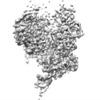
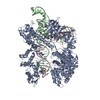
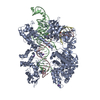
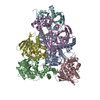


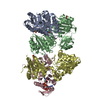


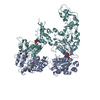
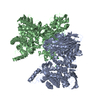

 Z (Sec.)
Z (Sec.) Y (Row.)
Y (Row.) X (Col.)
X (Col.)






















